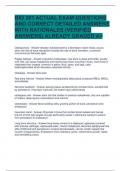BIO 201 ACTUAL EXAM QUESTIONS
AND CORRECT DETAILED ANSWERS
WITH RATIONALES (VERIFIED
ANSWERS) ALREADY GRADED A+
Osteoporosis - Answer-disease characterized by a decrease in bone mass; occurs
when the rate of bone resorption exceeds the rate of bone formation, a common
occurrence as the body ages
Pagets disease - Answer-overactive osteoclasts, new bone is weak and brittle, usually
over 40s, can cause headaches and hearing loss when occuring in brain. more bone is
reaborbed than created. common in pelvis, skull, spine, and legs. uses
bisphosphonates which decrease osteoclast activity.
Ostealgia - Answer-bone pain
Red bone marrow - Answer-where hematopoiesis takes place, produces RBCs, WBCs,
and platelets
flat bone sandwich - Answer-spongy tissue sandwiched by compact bone, sandwiched
by periosteum. if top layer fractures, the bottom layer still protects
osteogenic cell - Answer-stem cell that divides to produce osteoblasts, only one capable
of mitosis, deep layers of periosteum and marrow
osteoblasts - Answer-Bone building cells, growing portion of bone, periosteum and
endosteum
haversian canal - Answer-Channels in bone that contain blood vessels and nerves
branch off into right angles through perforating canals ( volkmanns canals) to extend
from periosteum to endosteum.
Long bone structure - Answer-long bones consist of a diaphysis, epiphysis (covered
with articular cartilage), epiphyseal plate ( meets metaphysis, becomes ephiphyseal line
after childhood) and periosteum( contains bloodvessels, nerves, lymph vessels that
nourish compact bone). Endosteum lines medullary cavity ( where bone growth, repair,
and remodeling occur)
, Bone cells and tissue - Answer-contains small amt of cells entrenched in matrix of
collagen ( gives flexibility) that is a surface for cal phos and cal carb that form
hydroxyapetite=gives bone hardness and strength
Osteocytes - Answer-Maintain mineral concentration of matrix where it is entrapped
Compact bone - Answer-Hard, dense bone tissue that is beneath the outer membrane
of a bone, concentric, circumferential, interstitial lamella.p perforating (volkmanns) canal
toward the central canal (haversian)
Spongy bone - Answer-Cancellous, osteocytes in lacunae but not arranged in
concentric circles, lacune are in lattice/network= trabeculae, forms along the lines of
stress. balance dense and heavy compact bone, houses RBM
Blood/ nerve supply - Answer-received by spongy and medullary cavity from arteries
that pass through compact bone though nutrient foramen (small openings in diaphysis).
nourishes osteocytes. circulates in marrow cavities, collected by veins and removed
through foramen. nerves help regulates this blood flow and bone growth, and
concentrate in metabolically active sites of bone.
Cartilage template - Answer-during fetal dev, a framework is a laid down, flexible, semi-
solid matric made from chondroblasts and hyaluronic acid, chondroitin sulfate, collagen
fibers, and water. cartilage is avascular.
IO - Answer-intramembranous ossification. utero-adolescence. allows skull and
shoulders to deform for birth. face bones are last to form mature adult face past
adolescence. flat bones of face, most cranial bones, and clavicles. forms compact and
spongy from sheets of mesenchymal (undifferentiated) connective tissue. mesenchymal
cells gather and differentiate into capillaries, osteogenic cells, and osteoblasts= secrete
osteoid (uncal matrix which hardens within a few days as min sals=ts are deposited and
entrap blasts become cytes)( blasts form in cluster-oss center). osteoid (unmineralized
matrix) secretes around capillaries (which condense to form bone marrow) and forms
trabecular matrix. blasts on surface become periosteum
Endochondral ossification - Answer-replaces hyaline cartilage. cartilage does not
become bone but serves as template to be completely replaced. longer than IO.
Mesenchymal cells differentiate into chondorcytes that form cart skel precursor (6-8
wks). Perichondrium forms and covers cart. uncalcified matrix in diaphysis forms
calcified matrix. nutrient artery supplies cal matrix to form spongy bone resulting in
primary oss center (2-3 month). secondary oss center forms in epiphysis and matrix
uncalcifies to form spongy tissue. articular cartilage forms around epiphysis (continues
to grow as epiphyeal plate). penetration of caps initiate the periochondrium to turn into
periosteum
EO - Answer-Endochondral ossification follows five steps. (a) Mesenchymal cells
differentiate into chondrocytes. (b) The cartilage model of the future bony skeleton and




